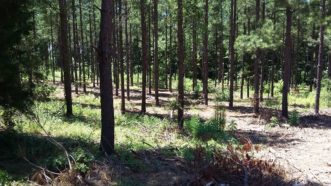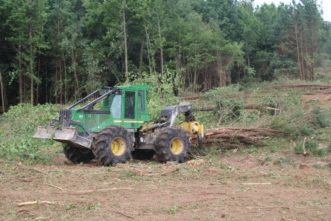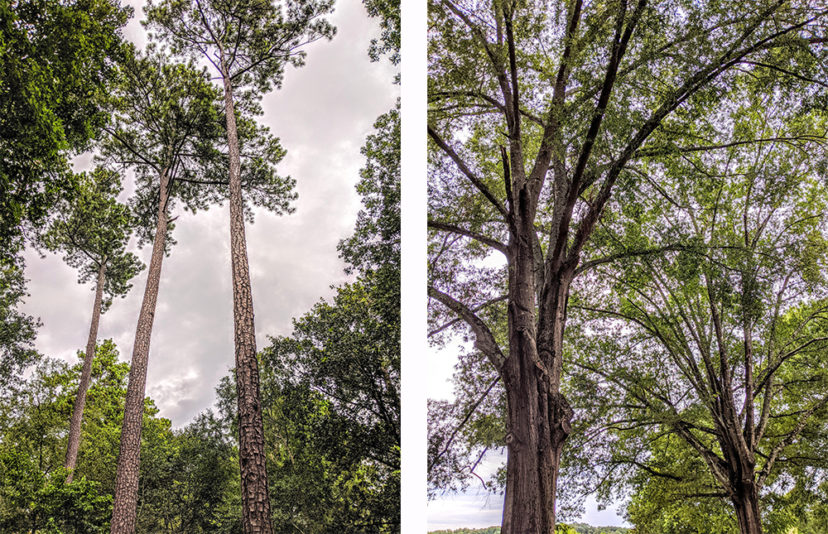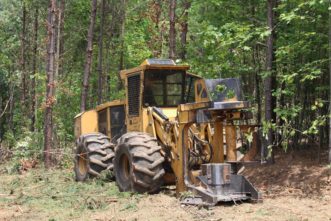Fully mechanized harvesting systems are the most productive and common harvesting systems in the United States. Stem size, stand density, species composition, silvicultural prescriptions, slope/terrain, and operator skill affect the productivity and cost of a harvesting system. Timber harvest expectations of foresters, landowners, and loggers are dependent on these factors. This article describes the factors affecting the productivity of specific harvesting machines used in whole-tree harvesting and impact on harvesting cost. Landowners will understand common limitations of a timber harvest, and they can be discussed with a forester or logger.
Introduction

Figure 1. A pine plantation that is managed for timber production. Image credit: Dr. Patrick Hiesl, Clemson University.
Harvesting operations play a significant role in sustainable forestry. Timber harvesting is used for managing a forest for different objectives such as timber production (figure 1), wildlife habitat management, recreation, and to reduce wildfire risk. There has been a gradual development and adaptation of logging equipment in the last hundred years. Change in the setup of logging businesses, forest ownerships, and the improvement of harvesting equipment has also taken place during that time. From the 1960s to 1980s, logging operations were rapidly mechanized, and the logging industry shifted from a labor-intensive to a capital-intensive industry.1,2 During the same time, the practice of silviculture and forest management has changed gradually.3 Clear cutting was widely practiced into the 1990s, but with an increased focus on sustainability, the intensity of clearcutting diminished in the early 2000s. At the same time, the concept of patch clearcutting(clear cutting trees in an area typically less than 1 acre in size), seed tree (cut most of the mature trees but leaves some widely spaced trees as a source for the natural regeneration), shelterwood (cut most trees in a stand but leave some behind to provide shade for regeneration) , single-tree selection systems (scattered single mature trees are harvested to release growing space to facilitate regeneration), and group-selection systems (two or more mature trees are harvested as a group) became more popular.4 While 45% of the world’s timber is harvested mechanically, the remaining 55% are harvested manually using a chainsaw or other tools.5 Even though there has been an increasing trend of adopting mechanized harvesting systems, chainsaw felling is still in prominent use in mountainous terrain and steep slope areas.6 In the western United States, chainsaws are mostly used as a tool for felling on steeper ground where skyline or helicopter yarding is primarily used to transport logs.7 Many states in the northeastern and midwestern United States have a significant percentage of their logging force using chainsaws.8,9 In the southern United States, the use of chainsaws for timber harvesting has decreased significantly in the past four decades. For instance, the percentage of Georgia loggers using chainsaws decreased from 21% in 1987 to only 2% in 2017.10 In South Carolina, less than 2% of respondents of a logging business survey in 2017 reported the use of a chainsaw harvesting system. 10

Figure 2. A grapple skidder pulling a load of pine trees (including branches and tops). Image credit: Dr. Patrick Hiesl, Clemson University.
The two most common mechanized harvesting methods are whole-tree (WT) and cut-to-length (CTL) harvesting. In WT, standing trees are cut down and separated from the stump and transported to the landing where they are processed into logs. The WT harvesting system usually consists of a feller-buncher to fell, a grapple skidder (figure 2) to drag bunched trees to the landing, and a delimber to remove limbs from the tree stems.11 In CTL, all processing (felling, delimbing, topping, bucking, and piling) is performed at the stump by a harvester. A forwarder will then accumulate the scattered log piles and transport them to the roadside.11 For a brief overview of mechanized harvesting equipment used in South Carolina, see Timber Harvesting Equipment in South Carolina. Tree length (TL) harvesting is usually a form of manual timber harvesting, where a tree is typically felled using a chainsaw, and tops and branches are removed at the stump, prior to extraction with a skidder. While TL is a traditional harvesting method applied in many southern states, its impact on annual timber production is minimal. CTL harvesting is commonly used in northern states and is infrequently used in the southern United States.6 The focus of this article is on WT harvesting systems using a feller-buncher, skidder, and delimber.
Factors Affecting Mechanized Harvesting Productivity
Harvesting equipment productivity studies have been conducted in the southern United States for most of the last century. Productivity is typically measured in the volume produced (tons) per hour of work (hours). These studies have shown that many factors influence individual machine productivity and, subsequently, harvesting cost. These factors include stem size, skidding distance, stand density, species composition, silvicultural prescriptions, stand regeneration methods, slope, and operator experience.12–15 Productivity can increase or decrease with small changes in any of these factors.
Stem Size
Stem size is a significant factor that affects the productivity of the feller-buncher.16 The felling head attached to the feller-buncher can cut various sizes of trees in approximately the same amount of time. Relatively large trees allow the machine to cut greater volumes of wood per machine hour.17 For example, a 0.4-inch increase in average tree diameter results in approximately a 10% increase in the productivity of the feller-buncher.18 Large trees can be difficult to handle by the feller-buncher, and the positioning and cutting time can increase, ultimately resulting in lower productivity. The positioning and felling time of trees having more than thirteen inches in diameter at breast height (dbh) is 75% higher than for trees between four to ten inches in dbh.18 Therefore, productivity increases at a decreasing rate with increasing stem size.19 However, the size that each feller-buncher can handle without losing productivity depends on the size of the feller-buncher and cutting head and likely varies with the operator.
The productivity of a skidder is highest when large trees are harvested, as the bunch volume per turn is greater.20 If the size of harvested trees is small, the number of stems grappled per turn is higher, but with a lower overall volume, thus reducing the skidder productivity.13 Skidding productivity can decrease by 14% when skidding smaller diameter trees.21 When large-sized stems are skidded, only a few stems are required to make a bunch, while small-sized stems require more stems and more time to build a bunch by the feller-buncher.22
Skidding Distance
The efficiency of a skidder is greatly affected by skidding distance because it strongly affects the skidding time.17 When the skidding distance is long, the skidding time increases, and the overall productivity decreases. Thus, shorter skidding distances lead to higher productivities.14 The decrease in productivity of the skidder due to longer skid distances can be somewhat counterbalanced by increasing the payload per turn. The skidding distance varies and is based on many factors such as terrain and stand shape and can range from less than a tenth of a mile to close to three-quarters of a mile. 16,23,24
Stand Density
Stand density is defined as the number of trees per unit of area; in the United States, this is typically measured in trees per acre. In most cases, the lower the stand density, the larger the distance between harvested trees. The time spent on driving to every single tree that is being harvested increases when tree spacing is increased. This increase in moving time decreases the production rate (trees cut per hour) of the feller-buncher.25 However, the larger volume of trees typically associated with a low stand density can compensate for this decrease in production and result in greater net productivity.26 Of course, this depends on the size of the feller-buncher and its diameter cutting capacity.
Species Composition
Pull-through delimber productivity depends on the characteristics of tree species and varies mostly with the hardwood content of a stand and the thickness of branches. The productivity of the pull-through delimber is lower in hardwood stands than in softwood stands. The main reasons are wood density and larger branch size of hardwood species (Figure 3).27 Although a hardwood species, yellow poplar stands yield the highest productivity. This is due to yellow poplar having a straight and clear bole with few branches.16 Delimbing time for hardwoods is also generally greater than for softwoods. For example, southern yellow pine has less delimbing time because they have a straight bole with few small branches at the crown. Small branches from softwood species can be delimbed using a delimbing knife, large branches from hardwood species need to be cut off using a saw. Some softwood species (such as eastern hemlock) are an exception and have a higher delimbing time due to larger branch size.

Figure 3. Branches of softwood species such as pine (left) typically occur in whirls around the main stem, are smaller in diameter, and grow out of the main stem almost perpendicular. The main stem of hardwood species, such as oak (right), typically fork into multiple large-diameter branches that grow out of the main stem at steep angles. Image credit: Manisha Parajuli, Clemson University.
Silvicultural prescription
Silvicultural prescription determines the type, quality, and quantity of wood to be harvested and significantly affects the productivity of harvesting operations.25,28 The choice of the silvicultural prescription depends on the landowner’s objective, species characteristics, and site conditions. Generally, harvesting productivity increases with higher removal intensity.14 Clearcutting has the highest removal intensity and results in a higher yield per acre because it removes all merchantable trees in one operation.14 In the southern United States, clearcutting is most prevalent in areas of managed pine plantations. Shelterwood systems are effective for natural reforestation but have a lower harvesting intensity than clearcutting systems due to the number of trees left standing for establishing regeneration.20,29 Selection systems remove individual or groups of trees distributed throughout the stand, resulting in the removal of fewer trees per hour. This increases the total moving time of the harvesting equipment and results in lower productivity per hour. However, each system is applied to different stand ages and is also affected by the associated stem sizes and stand density.
The methods of regeneration (natural or artificial) can also have a great impact on feller-buncher productivity. Clear cut stands of single species plantations are much more productive than thinning naturally regenerated mixed-species stands because plantation stands have a uniform tree spacing, similar tree dimensions, and a high volume per acre.30 For example, the harvesting productivity of industrial loblolly pine plantations is higher compared to a naturally regenerated stand of the same species.31
Slope
Steep slopes and uneven terrain negatively impact harvesting productivity.32 Modern fully mechanized harvesting equipment is designed for gentle terrain and is usually limited to slope gradients of less than 30°. Slope is an important determinant of machine stability, impacting travel speed, and duration of the work. Steep slopes also pose considerable safety concerns for equipment operators. As slope increases, the productivity of harvesting equipment decreases.
The rubber-tired feller-buncher (figure 4) is a productive machine for ground slopes less than 17°.7,18 While rubber-tired feller-bunchers are designed for relatively flat terrain, tracked feller-bunchers can handle steeper slopes. As the slope increases, the ability of the equipment to climb becomes more difficult and decreases the machine stability. Steep slopes cause harvesting difficulties and increase the handling time per tree. Minimal productivity decreases can be expected when the slope is 20% or less, productivity decreases noticeably between slopes between 21% and 30%, while steeper slopes of 31% or more result in major productivity decreases.33 On steep slope landscapes, tracked feller-bunchers need a self-leveling operator cabin to automatically adjust the position of the operator with respect to the ground surface. This distributes the weight uphill for increased stability, gives a better view of the trees to the operator, increases the harvesting efficiency when operating in steep terrain, and provides the operator with a more comfortable operating position.33,34
Grapple skidders cannot be operated effectively in steep slope areas because there is a higher risk of the machines slipping sideways and rolling over. When the ground slope on the skid trail is steep, the skidder travels at lower speeds, which results in increased cycle time for each turn. On steep uphill trails, greater load weight also reduces the travel speed.17 Skidding productivity on very steep slopes can be reduced up to 45%, compared to flat terrain operations, thus skidding on a slope greater than 26° should be avoided to prevent major productivity decreases.35 In addition, slippage of wheels and rolling over must be avoided because it causes damage to the soil, disturbs soil fauna and plants, causes equipment damage, and can harm equipment operators.
Operator
The skill of the operator plays an important role in determining the productivity of the harvesting equipment.36 The difference in productivity is due to different cutting techniques, work experiences, work planning, felling order, and operators’ dexterity.37 The operator has some control over the average skid distance and the size of payload per cycle, which can impact the productivity of the skidder.14,38 Operator skill in combination with the machine and site condition affects the efficiency of the grapple skidder and feller-buncher by up to thirty percent.12 An operator also plays a vital role in controlling stand damage caused by harvesting equipment.12 In addition, the type of stand (pure conifer or mixed wood stand) significantly affects the operator’s efficiency. Operating in a mixed wood stand requires strong mental focus and increases mental workload, which leads to mental fatigue. This results in a loss of productivity between 40% and 57% as compared to the productivity of harvesting pure conifer stands.39
Harvesting Cost
The profitability of harvesting operations is a major concern to loggers and landowners. The cost per unit of wood (i.e., $/ton) depends on machine productivity, operating cost, and technical efficiency. Technical efficiency is the effectiveness with which a given set of input factors is used to produce an output (i.e., the right machines for the job). It can have a significant impact on economics, with higher technical efficiency lowers the cost of harvesting.40 Higher productivity of the WT harvesting system results in lower harvesting cost. Harvest profitability is greatest when removing large trees at high harvesting intensity.22 Generally, as tree size increases, the productivity increases, and the unit cost of wood produced decreases. But one should be aware that a continuous increase in tree size triggers a reduction in productivity because of the difficulty in handling very large-sized trees. Harvesting smaller diameter trees costs more than larger diameter trees. Harvesting lower volumes per acre costs more than higher volumes per acre. High harvest intensities produce higher levels of profitability in all product classes and for all diameters. Harvesting costs are also highly influenced by slope and operator experience. In steep slope stands, the feller-buncher and skidder typically operate at lower speeds to prevent slipping and rollover, resulting in longer time needed to perform each logging activity, lowers the system productivity, and consequently increases the production cost. In addition, loggers with lower technical efficiency always result in higher production costs as compared to loggers with higher efficiency. The maximum profit can be expected when a logger achieves highest technical efficiency, minimizes average unit cost, and maximizes unit production.40
Conclusion
There are many factors that affect the productivity and the cost of a harvesting operation, many of which are out of a forest manager’s control. High productivity results in a lower cost and can be obtained by maximizing unit production by using technically efficient harvesting equipment, eliminating greater slope, and using skilled operators. Being aware of the specific challenges that a forest stand provides will allow the logger, forester, and landowner to determine productivity and cost expectations for a given harvest, and ultimately a realistic stumpage value. Apart from the machine productivity and cost, it is also important to consider the environmental consequences of WT harvesting systems over CTL systems. Cut-to-length harvesting systems cause less damage to the soil and associated biomes as it creates slash mats with the removed tree limbs and prevents direct contact between machine tires and soil surfaces. In comparison, WT harvesting causes more damage to soil and associated biomes because the skidder drags bunches of trees across the landscape, thus sweeping away litter, damaging surface roots, and exposing mineral soil.41,42
Acknowledgments
Funding for this article was provided through a joint-venture agreement (19-JV-11330132-087) with the US Forest Service, Southern Research Station in Auburn, Alabama.
References
- Lebel L. Production capacity utilization in the southern logging industry. (Doctoral dissertations, Virginia Tech); 1993.
- Loving E. Components of logging costs. (Doctoral dissertation, Virginia Tech).;1991.
- D’Amato AW, Jokela EJ, O’Hara KL, Long JN. Silviculture in the United States: an amazing period of change over the past 30 years. Journal of Forestry. 2017;116(1):55–67.
- D’Amato AW, Bolton NW, Blinn CR, Ek AR. Current status and long-term trends of silvicultural practices in Minnesota: a 2008 assessment. 2009;(205).
- Ponsse O. The cut to length harvesting system. November 27. 2005. https://www.ponsse.com/#/
- Conrad JL, Greene WD, Hiesl P. A review of changes in US logging businesses 1980s-present. Journal of Forestry. 2018;116(3):291–303.
- Han H-S, Renzie C. Effect of ground slope, stump diameter, and species on stump height for feller-buncher and chainsaw felling. International Journal of Forest Engineering. 2005;16(2):81–88.
- Allred S, Michler C, Mycroft C. Midwest logging firm perspectives: harvesting on increasingly parcelized forestlands. International Journal of Forestry Research. 2011;2011:8.
- Leon BH, Benjamin JG. A survey of business attributes, harvest capacity and equipment infrastructure of logging business in the Northern forest. School of Forest Resources, University of Maine, Orono. 2012:29 p.
- Conrad JL, Greene WD, Hiesl P. The evolution of logging businesses in Georgia 1987-2017 and South Carolina 2012-2017. Forest Science. 2018;64(6):671–681.
- Adebayo AB, Han HS, Johnson L. Productivity and cost of cut-to-length and whole-tree harvesting in a mixed-conifer stand in northern Idaho. Forest Products Journal. 2007;57(6):59–69.
- Hiesl P. Productivity standards for whole-tree and cut-to-length harvesting systems in Maine. (Electronic Theses and dissertations, The University of Maine); 2013.
- Tufts RA, Stokes BJ, Lanford BL. Productivity of grapple skidders in southern pine. Forest Products Journal. 1988;38(10):24–30.
- Kluender R, Stokes BJ. Productivity and costs of three harvesting methods. Southern Journal of applied forestry. 1994;18(4).
- Landford BL, Sirois D. Drive-to- tree, rubber-tired feller buncher production studies. US Department of Agriculture, Forest Service, Southern Forest Experiment Station General Technical Report SO-45. 1983;45:14 p.
- Wang J, Long C, McNeel J. Production and cost analysis of a feller-buncher and grapple skidder in central Appalachian hardwood forests. Forest Products Journal. 2004;54(12):159–167.
- Akey AE, Erdas O, Sessions J. Determining productivity of mechanized harvesting machines. Journal of Applied Sciences. 2004;4(1):100–105.
- Gingras J-F. The effect of site and stand factors on feller-buncher performance. Technical Report – Forest Engineering Research Institute of Canada. 1988:1–18.
- Visser R, Spinelli R. Determining the shape of the productivity function for mechanized felling and felling-processing. Journal of Forest Research. 2012;17(5):397–402.
- Kluender R, Lortz D, Mccoy W, Stokes B, Klepac J. Productivity of rubber-tired skidders in southern Pine forests. Forest Products Journal. 1997;47(11–12):53–58.
- Li Y, Wang J, Mcneel J. Production economics of harvesting small-diameter hardwood stands in central Appalachia. Forest Products Journal. 2006;56(2936):3–8.
- Kluender R, Lortz D, Stokes B, Klepac J. Removal intensity and tree size effects on harvesting cost and profitability. Forest Products Journal. 1998;48:54–59.
- Hiesl P, Benjamin JG. Can technology help improve grapple skidder and stroke delimber interactions? A simulation approach. International Journal of Forest Engineering. 2015;26(3):171–184. doi:10.1080/14942119.2015.1108038
- Kelly MC, Germain RH, Bick S. Impacts of Forestry Best Management Practices on Logging Costs and Productivity in the Northeastern USA. Journal of Forestry. 2017;115(6):503–512. doi:10.5849/jof.2016-031r1
- Soman H, Kizha AR, Roth BE. Impacts of silvicultural prescriptions and implementation of best management practices on timber harvesting costs. International Journal of Forest Engineering. 2019;30(1):14–25.
- Winsauer SA, Mattson JA, Thompson MA. Feller/bunchers in plantation thinnings : factors affecting productivity. U.S Department of Agriculture, Forest Service, North Central Forest Experiment Station; 1984.
- Sionneau J, Cuchet E. Mechanization of thinnings in hardwood, the French experience. Proceedings of the IUFRO meeting; Quebec, Canada. 2001:(8).
- Wilson B, Wilson L. An economic perspective on clearcut harvesting. The Forestry Chronicle. 2001;77(36):467–473.
- Lortz D, Kulender R, McCOY W, Stokes B, Klepac J. Manual felling time and productivity in southern pine forests. Forest Products Journal. 1997;47:59–63.
- Hiesl P, Benjamin JG. Applicability of international harvesting equipment productivity studies in Maine, USA: A literature review. Forests. 2013;4:898–921.
- Stanturf JA, Kellison RC, Broerman FS, Jones SB. Productivity of southern pine plantations: where are we and how did we get here? Journal of Forestry. 2003;101(4):26–31.
- Heinimann HR. Ground-based harvesting technologies for steep slopes. In: Proceedings of the International Mountain Logging and 10th Pacific Northwest Skyline Symp., Corvallis, OR, 1999. 1999. p. 1–19.
- Gingras J-F. Feller-buncher performance in adverse stand and terrain conditions. Technical Report – Forest Engineering Research Institute of Canada. 1989:1–10.
- Visser R, Stampfer K. Expanding ground-based harvesting onto steep terrain: a review. Croatian Journal of Forest Engineering. 2015;36(2):321–331.
- Diniz CCC, Nakajima NY, Robert RCG, Dolácio CJF, da Silva FA, Balensiefer DF. Performance of grapple skidder in different ground inclinations. Floresta. 2019;49(1):41–48.
- Kärhä K, Rönkkö E, Gumse S-I. Productivity and cutting costs of thinning harvesters. International Journal of Forest Engineering. 2004;15(2):43–56.
- Ovaskainen H, Uusitalo J, Väätäinen K. Characteristics and significance of a harvester operators’ working technique in thinnings. International Journal of Forest Engineering. 2004;15(2):67–77.
- Egan AF, Baumgras JE. Ground skidding and harvested stand attributes in Appalachian hardwood stands in West Virginia. Forest Products Journal. 2003;53(9):59–63.
- Spinelli R, Magagnotti N, Labelle ER. The effect of new silvicultural trends on mental workload of harvester Operators. Croatian journal of forest engineering. 2020;41(2):1–14.
- Lebel L, Stuart WS. Technical efficiency evaluation of logging contractors using a Nonparametric model. Journal of Forest Engineering. 1998;9(2):15–24.
- Hartsough BH, Drews ES, McNeel JF, Durtson TA, Stokes BJ. Comparison of mechanized systems for thinning ponderosa pine and mixed conifer stands. Forest Products Journal. 1997:59–68.
- Han SK, Han SH, Johnson LR, Page-Dumroese. Impacts on soils from cut-to-length and whole-tree harvesting. (Doctoral dissertation, University of Idaho); 2006.


